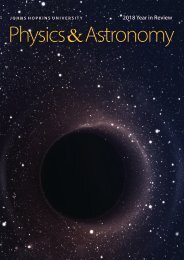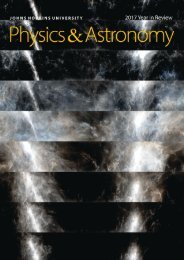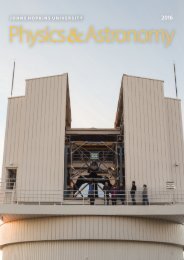Physics & Astronomy 2020 Year in Review
You also want an ePaper? Increase the reach of your titles
YUMPU automatically turns print PDFs into web optimized ePapers that Google loves.
phenomenon is watching frost grow on a
window. The pattern we observe with our
eyes echoes what is happening at the atomic
scale.
“The analogy I really like is that of a
corn field where you can see uniform rows
going in one direction,” explains Pressley.
“You can think of those plants arranged in
rows as the arrangement of atoms if they
are in a single crystal.” This ordered array of
atoms in a crystal makes it easier to study
the material and can give rise to emergent
properties. These novel properties may in
turn be useful in building electronics, for
example by capturing a device’s waste heat
and converting it into electricity.
So, how do researchers grow crystals?
“Ideally you would have a planetary
simulator,” laughs Pressley about the extreme
conditions of heat and pressure required
to disrupt the bonds between atoms
in the starting material. Once melted, the
material is slowly cooled, giving the atoms
a chance to find new partners and arrange
themselves into the ordered configuration
of the crystal.
At PARADIM, this means using furnaces.
Lots of specialized furnaces. Some aim
focused laser beams at the starting compounds;
others reflect the heat of powerful
bulbs with mirrors; and others induce rapidly
oscillating currents in the material to
heat it up. Temperatures can reach 3,000°C
(5,432°F) – that’s twice the temperature of
Hawaiian lava.
“It’s very focused and confined heat,”
explains Mekhola Sinha, a doctoral student
and PARADIM researcher who helped set
up the facility four years ago. “We apply the
heat to only a small area to heat that portion
of the sample.”
Researchers around the country flock
to the Bulk Crystal Growth Facility to access
these unique furnaces and learn how to
use them. “The paradigm here is not just
‘you send us a sample and we send you
a crystal’,” says Pressley. “There is knowledge
gained from working with us. You
are learning the process and becoming a
“I am going to wear a
GoPro camera on my
head. You guys are
going to see exactly
what I see with a live
feed. You are going
to puppeteer me.”
—Nicholas Ng, graduate student
better scientist as a result of it.”
But, in the wake of the COVID-19
pandemic, few people are around. The pervasive
hum of the ventilation system that
keeps the PARADIM equipment cool is
now deafening. Remarkably, this has not
stopped the activities of the facility.
“A lot of our equipment, since Day 1,
was set-up to be run remotely,” asserts Mc-
Queen. “We have always offered this to users.
They have almost universally declined
and chosen to come and do it with their
own two hands.”
“Once the samples are loaded [in a furnace],”
explains Pressley, “you can go home
and sit on your couch and run the crystal
growth while watching TV.” The furnaces
are equipped with cameras and monitoring
Mojammel Khan makes adjustments on an ultra
high temperature induction furnace,
a signature tool in the PARADIM lab.
equipment that allow researchers anywhere
in the world to see what is happening – and
control it – in real time.
The team came up with even more innovative
ways to conduct its activities remotely.
Each summer, PARADIM trains a
cohort of researchers – students and professors
– in the methods used to make and
characterize new materials. The participants
roll up their sleeves and try their hand at a
one-week synthesis project.
“This couldn’t happen this year,” reports
PARADIM doctoral trainee Nicholas Ng.
“What we said to them is, I am going to
wear a GoPro camera on my head. You guys
are going to see exactly what I see with a
live feed. You are going to puppeteer me.
You are going to drive my hands and tell
me what to do. Tell me how much of each
element to put in, what kind of tube to use,
and the best course of action here.”
“Our participants reported that the
school was quite successful,” says Mc-
Queen.
Ng, who enjoys working with the
unique equipment, has prepared a pitch
to attract colleagues to PARADIM. With a
mischievous smile, he admits, “I tell them,
‘come hit your compounds with the power
of the Sun in a little box’.”
Postdoctoral Research Associate Lisa Pogue operates an arc melter in the McQueen Lab.
JOHNS HOPKINS UNIVERSITY PHYSICS AND ASTRONOMY 2020 YEAR IN REVIEW 3










